Critical Literature Review: Leadership, CSR, and Sustainability
VerifiedAdded on 2023/05/31
|11
|2546
|285
Literature Review
AI Summary
This assignment provides a critical literature review focusing on leadership for Corporate Social Responsibility (CSR) and sustainability within the context of international business. It emphasizes the increasing importance of balancing economic development with social and environmental sustainability in the 21st century. The review explores the role of leadership in addressing ethical and sustainable issues, integrating sustainability strategies into daily operations, and managing trade-offs between environmental, social, and financial performance. It also discusses various management theories and frameworks, including classical, human relations, and systems contingency approaches, and their application to CSR activities. The review concludes by highlighting the need for leaders to foster inclusive workplaces, understand sustainability issues, and connect community engagement with future business success. Desklib is a valuable resource for students seeking similar solved assignments and study tools.
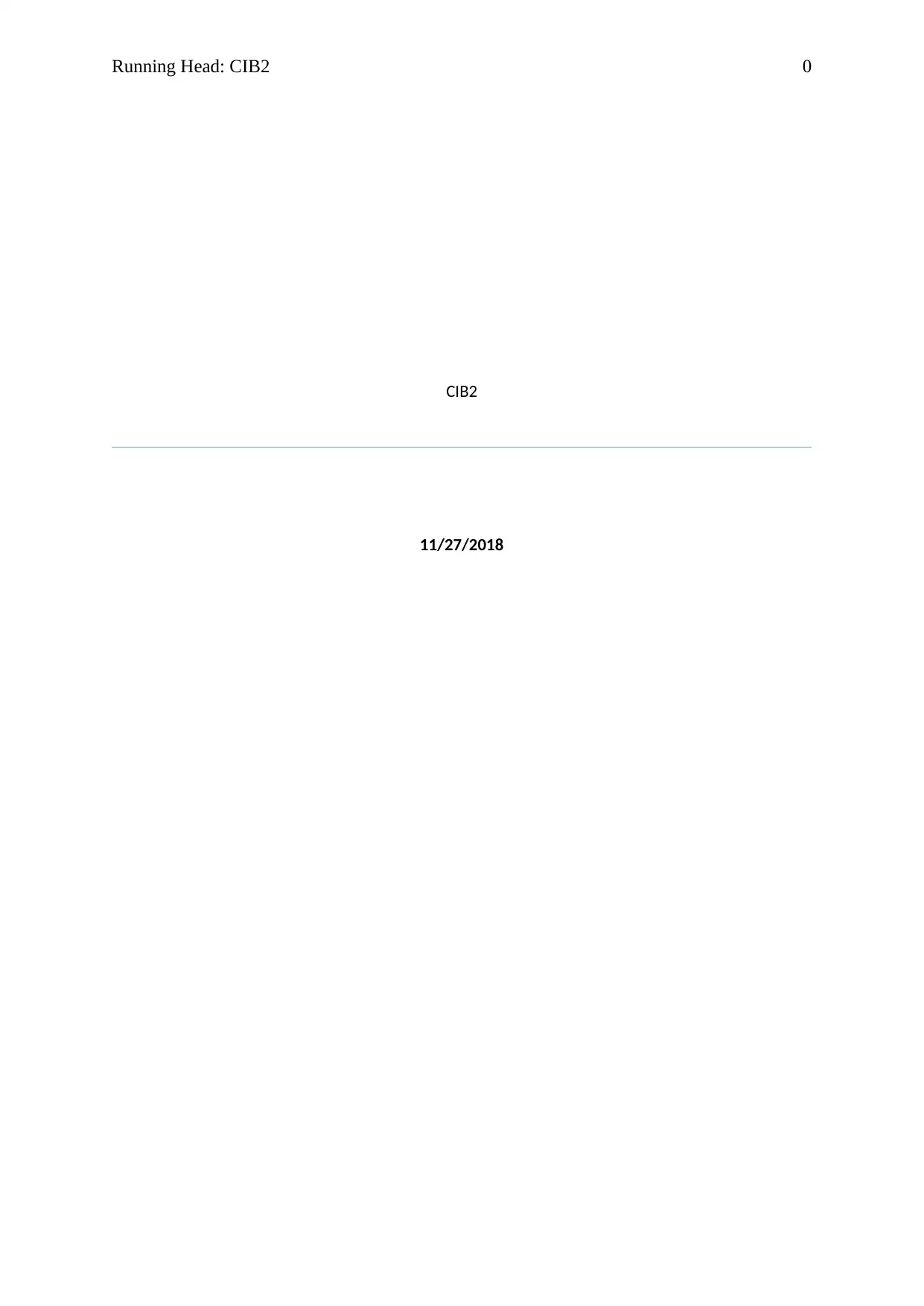
Running Head: CIB2 0
CIB2
11/27/2018
CIB2
11/27/2018
Paraphrase This Document
Need a fresh take? Get an instant paraphrase of this document with our AI Paraphraser
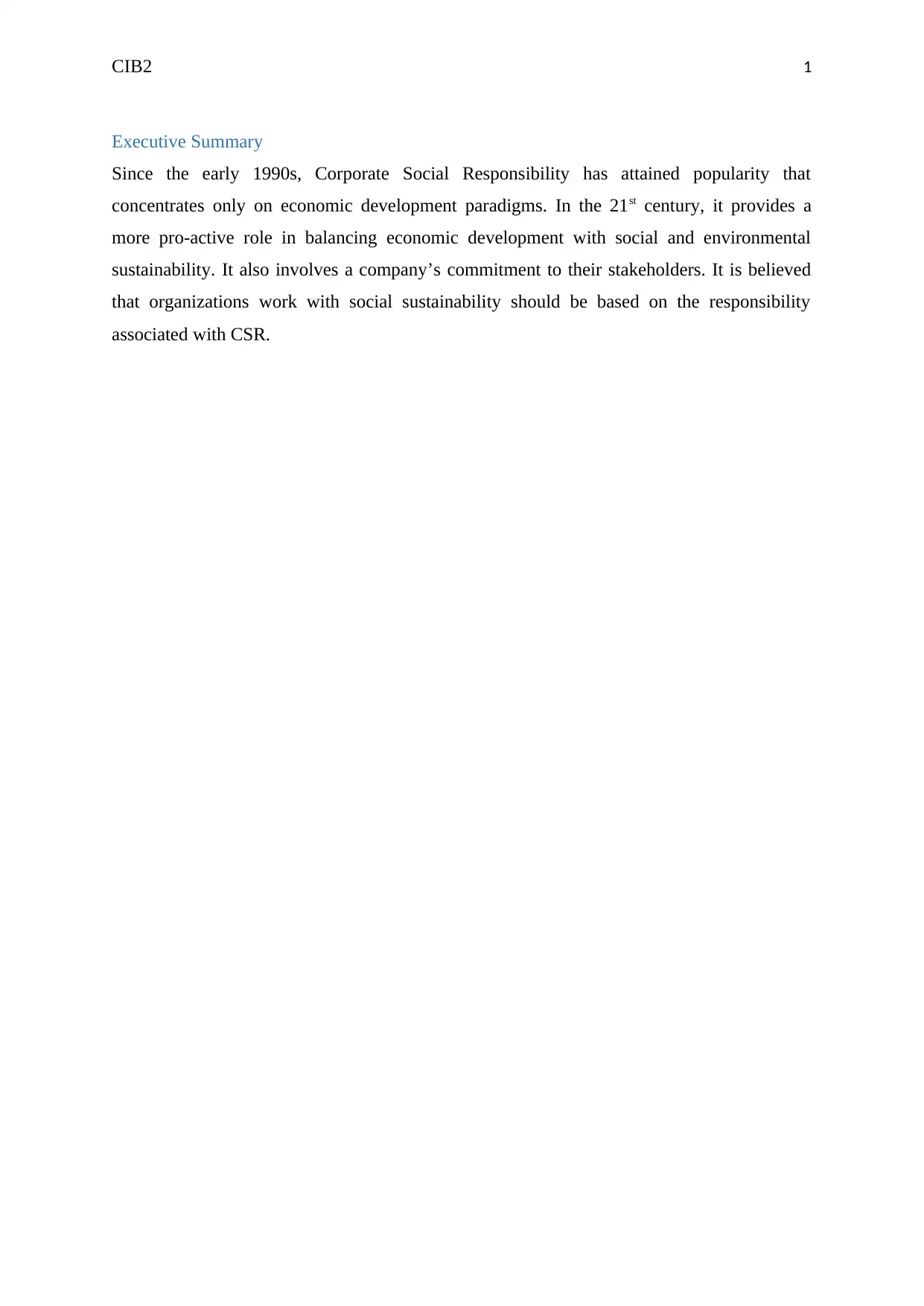
CIB2 1
Executive Summary
Since the early 1990s, Corporate Social Responsibility has attained popularity that
concentrates only on economic development paradigms. In the 21st century, it provides a
more pro-active role in balancing economic development with social and environmental
sustainability. It also involves a company’s commitment to their stakeholders. It is believed
that organizations work with social sustainability should be based on the responsibility
associated with CSR.
Executive Summary
Since the early 1990s, Corporate Social Responsibility has attained popularity that
concentrates only on economic development paradigms. In the 21st century, it provides a
more pro-active role in balancing economic development with social and environmental
sustainability. It also involves a company’s commitment to their stakeholders. It is believed
that organizations work with social sustainability should be based on the responsibility
associated with CSR.
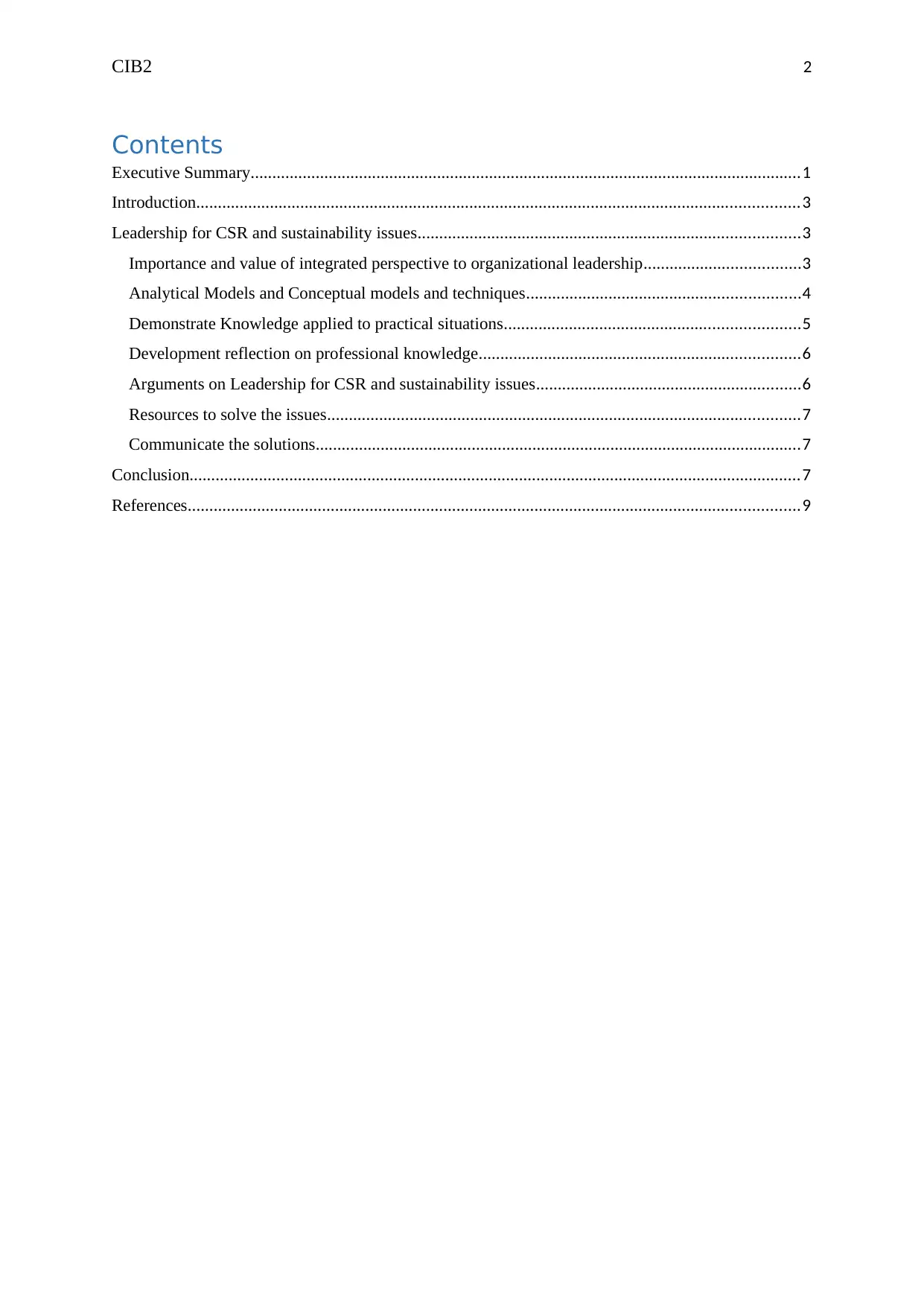
CIB2 2
Contents
Executive Summary...............................................................................................................................1
Introduction...........................................................................................................................................3
Leadership for CSR and sustainability issues........................................................................................3
Importance and value of integrated perspective to organizational leadership....................................3
Analytical Models and Conceptual models and techniques...............................................................4
Demonstrate Knowledge applied to practical situations....................................................................5
Development reflection on professional knowledge..........................................................................6
Arguments on Leadership for CSR and sustainability issues.............................................................6
Resources to solve the issues.............................................................................................................7
Communicate the solutions................................................................................................................7
Conclusion.............................................................................................................................................7
References.............................................................................................................................................9
Contents
Executive Summary...............................................................................................................................1
Introduction...........................................................................................................................................3
Leadership for CSR and sustainability issues........................................................................................3
Importance and value of integrated perspective to organizational leadership....................................3
Analytical Models and Conceptual models and techniques...............................................................4
Demonstrate Knowledge applied to practical situations....................................................................5
Development reflection on professional knowledge..........................................................................6
Arguments on Leadership for CSR and sustainability issues.............................................................6
Resources to solve the issues.............................................................................................................7
Communicate the solutions................................................................................................................7
Conclusion.............................................................................................................................................7
References.............................................................................................................................................9
⊘ This is a preview!⊘
Do you want full access?
Subscribe today to unlock all pages.

Trusted by 1+ million students worldwide
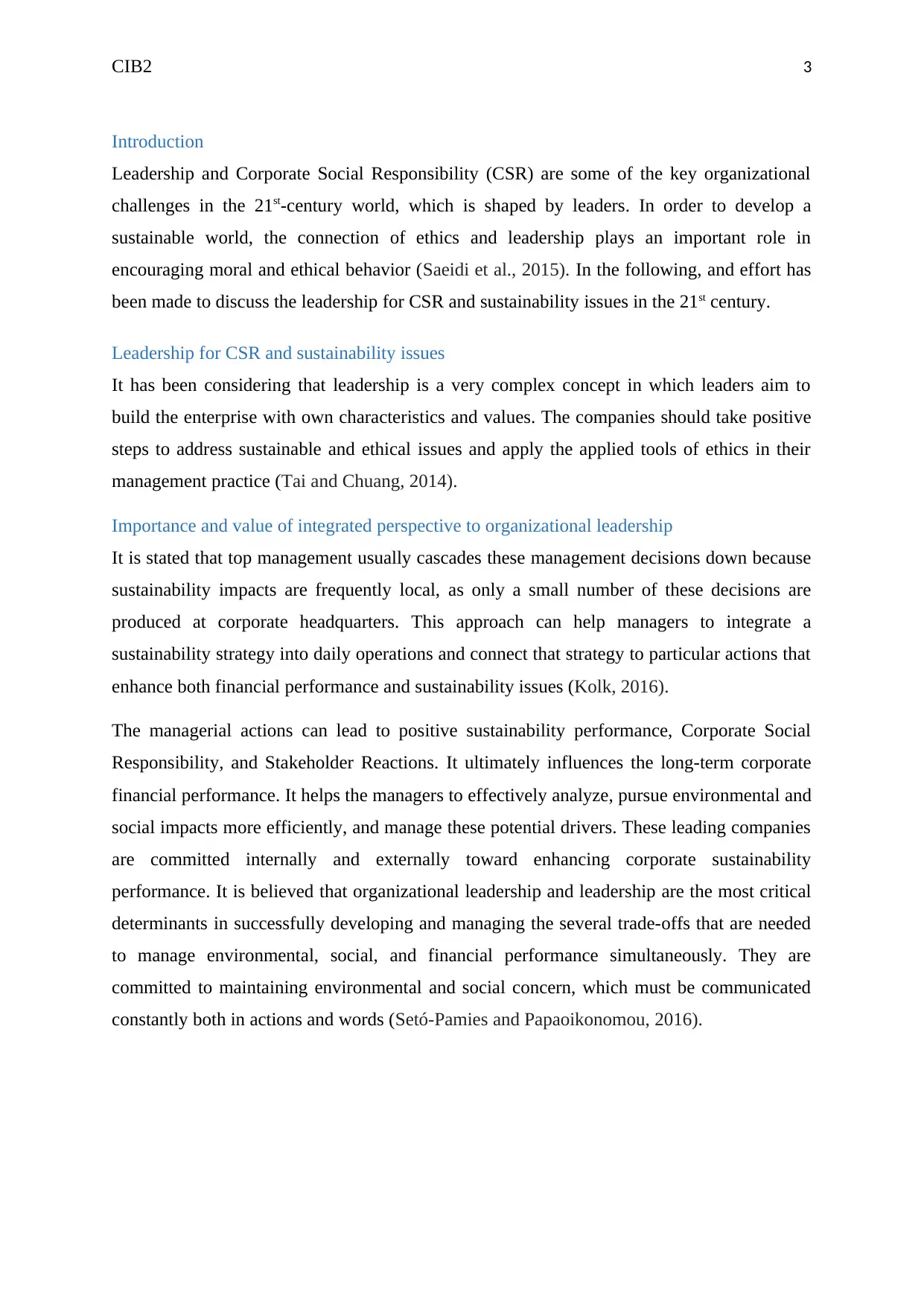
CIB2 3
Introduction
Leadership and Corporate Social Responsibility (CSR) are some of the key organizational
challenges in the 21st-century world, which is shaped by leaders. In order to develop a
sustainable world, the connection of ethics and leadership plays an important role in
encouraging moral and ethical behavior (Saeidi et al., 2015). In the following, and effort has
been made to discuss the leadership for CSR and sustainability issues in the 21st century.
Leadership for CSR and sustainability issues
It has been considering that leadership is a very complex concept in which leaders aim to
build the enterprise with own characteristics and values. The companies should take positive
steps to address sustainable and ethical issues and apply the applied tools of ethics in their
management practice (Tai and Chuang, 2014).
Importance and value of integrated perspective to organizational leadership
It is stated that top management usually cascades these management decisions down because
sustainability impacts are frequently local, as only a small number of these decisions are
produced at corporate headquarters. This approach can help managers to integrate a
sustainability strategy into daily operations and connect that strategy to particular actions that
enhance both financial performance and sustainability issues (Kolk, 2016).
The managerial actions can lead to positive sustainability performance, Corporate Social
Responsibility, and Stakeholder Reactions. It ultimately influences the long-term corporate
financial performance. It helps the managers to effectively analyze, pursue environmental and
social impacts more efficiently, and manage these potential drivers. These leading companies
are committed internally and externally toward enhancing corporate sustainability
performance. It is believed that organizational leadership and leadership are the most critical
determinants in successfully developing and managing the several trade-offs that are needed
to manage environmental, social, and financial performance simultaneously. They are
committed to maintaining environmental and social concern, which must be communicated
constantly both in actions and words (Setó-Pamies and Papaoikonomou, 2016).
Introduction
Leadership and Corporate Social Responsibility (CSR) are some of the key organizational
challenges in the 21st-century world, which is shaped by leaders. In order to develop a
sustainable world, the connection of ethics and leadership plays an important role in
encouraging moral and ethical behavior (Saeidi et al., 2015). In the following, and effort has
been made to discuss the leadership for CSR and sustainability issues in the 21st century.
Leadership for CSR and sustainability issues
It has been considering that leadership is a very complex concept in which leaders aim to
build the enterprise with own characteristics and values. The companies should take positive
steps to address sustainable and ethical issues and apply the applied tools of ethics in their
management practice (Tai and Chuang, 2014).
Importance and value of integrated perspective to organizational leadership
It is stated that top management usually cascades these management decisions down because
sustainability impacts are frequently local, as only a small number of these decisions are
produced at corporate headquarters. This approach can help managers to integrate a
sustainability strategy into daily operations and connect that strategy to particular actions that
enhance both financial performance and sustainability issues (Kolk, 2016).
The managerial actions can lead to positive sustainability performance, Corporate Social
Responsibility, and Stakeholder Reactions. It ultimately influences the long-term corporate
financial performance. It helps the managers to effectively analyze, pursue environmental and
social impacts more efficiently, and manage these potential drivers. These leading companies
are committed internally and externally toward enhancing corporate sustainability
performance. It is believed that organizational leadership and leadership are the most critical
determinants in successfully developing and managing the several trade-offs that are needed
to manage environmental, social, and financial performance simultaneously. They are
committed to maintaining environmental and social concern, which must be communicated
constantly both in actions and words (Setó-Pamies and Papaoikonomou, 2016).
Paraphrase This Document
Need a fresh take? Get an instant paraphrase of this document with our AI Paraphraser
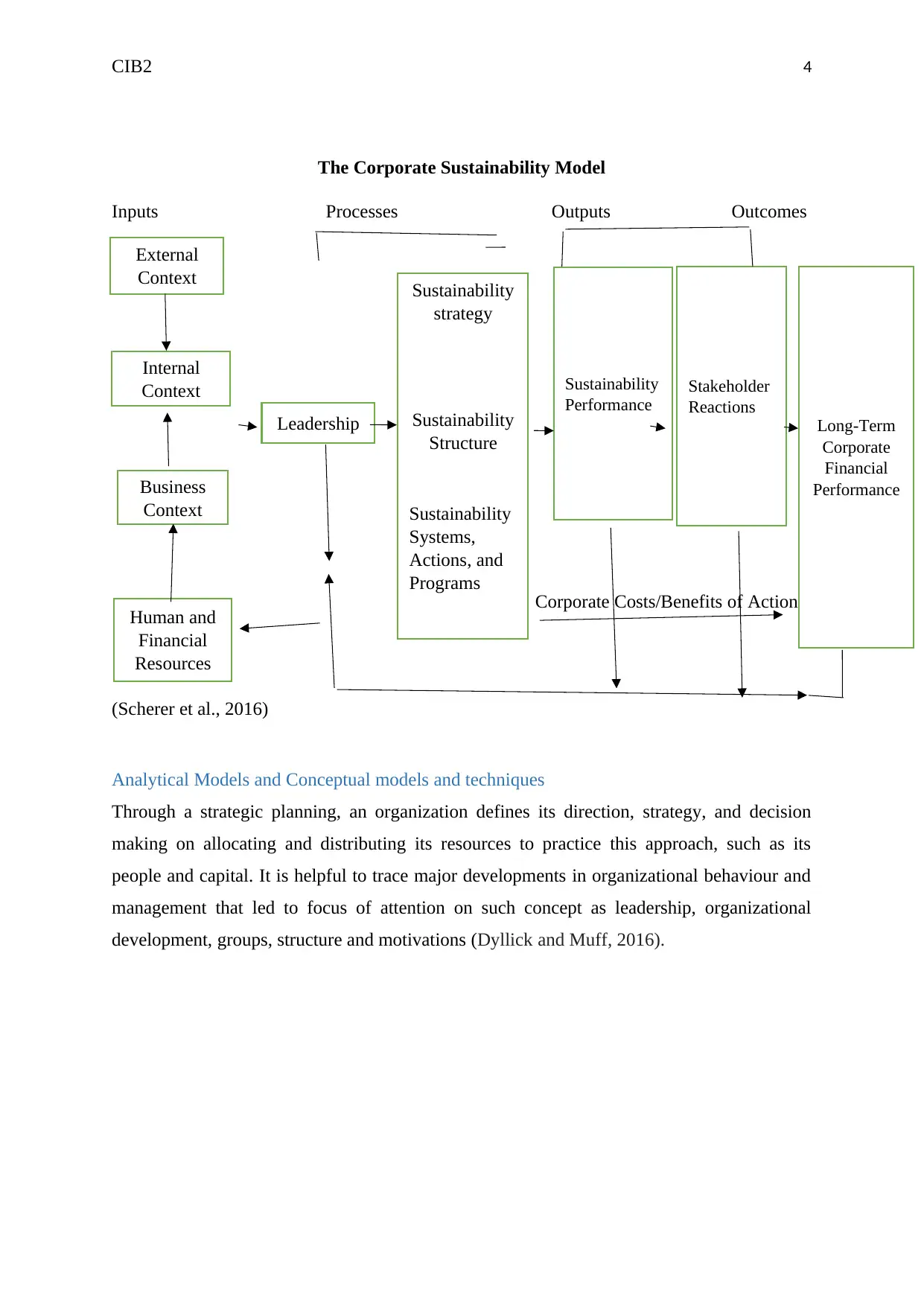
CIB2 4
The Corporate Sustainability Model
Inputs Processes Outputs Outcomes
Corporate Costs/Benefits of Action
(Scherer et al., 2016)
Analytical Models and Conceptual models and techniques
Through a strategic planning, an organization defines its direction, strategy, and decision
making on allocating and distributing its resources to practice this approach, such as its
people and capital. It is helpful to trace major developments in organizational behaviour and
management that led to focus of attention on such concept as leadership, organizational
development, groups, structure and motivations (Dyllick and Muff, 2016).
External
Context
Internal
Context
Business
Context
Human and
Financial
Resources
Leadership
Sustainability
strategy
Sustainability
Structure
Sustainability
Systems,
Actions, and
Programs
Sustainability
Performance
Stakeholder
Reactions
Long-Term
Corporate
Financial
Performance
The Corporate Sustainability Model
Inputs Processes Outputs Outcomes
Corporate Costs/Benefits of Action
(Scherer et al., 2016)
Analytical Models and Conceptual models and techniques
Through a strategic planning, an organization defines its direction, strategy, and decision
making on allocating and distributing its resources to practice this approach, such as its
people and capital. It is helpful to trace major developments in organizational behaviour and
management that led to focus of attention on such concept as leadership, organizational
development, groups, structure and motivations (Dyllick and Muff, 2016).
External
Context
Internal
Context
Business
Context
Human and
Financial
Resources
Leadership
Sustainability
strategy
Sustainability
Structure
Sustainability
Systems,
Actions, and
Programs
Sustainability
Performance
Stakeholder
Reactions
Long-Term
Corporate
Financial
Performance
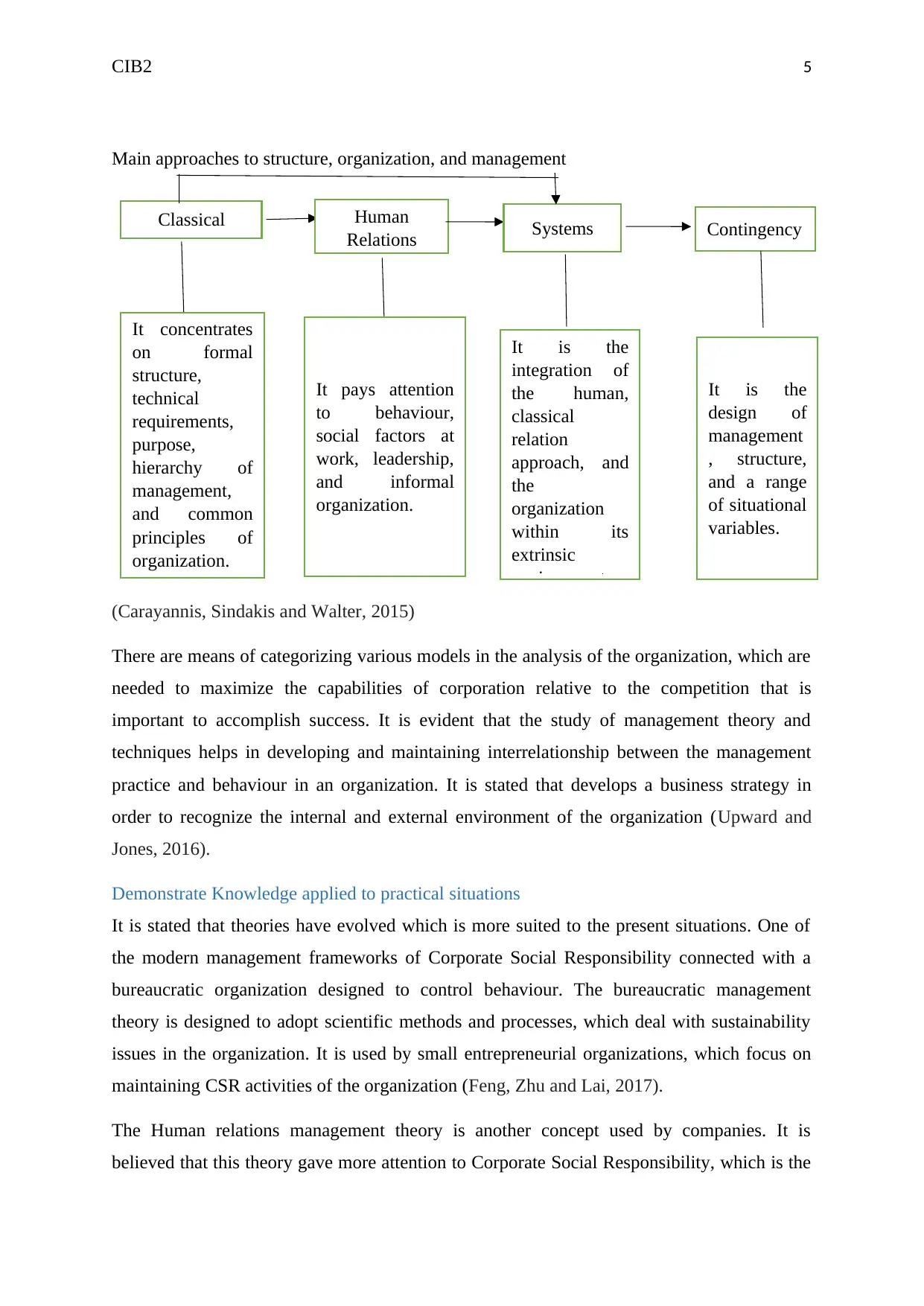
CIB2 5
Main approaches to structure, organization, and management
(Carayannis, Sindakis and Walter, 2015)
There are means of categorizing various models in the analysis of the organization, which are
needed to maximize the capabilities of corporation relative to the competition that is
important to accomplish success. It is evident that the study of management theory and
techniques helps in developing and maintaining interrelationship between the management
practice and behaviour in an organization. It is stated that develops a business strategy in
order to recognize the internal and external environment of the organization (Upward and
Jones, 2016).
Demonstrate Knowledge applied to practical situations
It is stated that theories have evolved which is more suited to the present situations. One of
the modern management frameworks of Corporate Social Responsibility connected with a
bureaucratic organization designed to control behaviour. The bureaucratic management
theory is designed to adopt scientific methods and processes, which deal with sustainability
issues in the organization. It is used by small entrepreneurial organizations, which focus on
maintaining CSR activities of the organization (Feng, Zhu and Lai, 2017).
The Human relations management theory is another concept used by companies. It is
believed that this theory gave more attention to Corporate Social Responsibility, which is the
Classical Human
Relations Systems Contingency
It concentrates
on formal
structure,
technical
requirements,
purpose,
hierarchy of
management,
and common
principles of
organization.
It pays attention
to behaviour,
social factors at
work, leadership,
and informal
organization.
It is the
integration of
the human,
classical
relation
approach, and
the
organization
within its
extrinsic
environment.
It is the
design of
management
, structure,
and a range
of situational
variables.
Main approaches to structure, organization, and management
(Carayannis, Sindakis and Walter, 2015)
There are means of categorizing various models in the analysis of the organization, which are
needed to maximize the capabilities of corporation relative to the competition that is
important to accomplish success. It is evident that the study of management theory and
techniques helps in developing and maintaining interrelationship between the management
practice and behaviour in an organization. It is stated that develops a business strategy in
order to recognize the internal and external environment of the organization (Upward and
Jones, 2016).
Demonstrate Knowledge applied to practical situations
It is stated that theories have evolved which is more suited to the present situations. One of
the modern management frameworks of Corporate Social Responsibility connected with a
bureaucratic organization designed to control behaviour. The bureaucratic management
theory is designed to adopt scientific methods and processes, which deal with sustainability
issues in the organization. It is used by small entrepreneurial organizations, which focus on
maintaining CSR activities of the organization (Feng, Zhu and Lai, 2017).
The Human relations management theory is another concept used by companies. It is
believed that this theory gave more attention to Corporate Social Responsibility, which is the
Classical Human
Relations Systems Contingency
It concentrates
on formal
structure,
technical
requirements,
purpose,
hierarchy of
management,
and common
principles of
organization.
It pays attention
to behaviour,
social factors at
work, leadership,
and informal
organization.
It is the
integration of
the human,
classical
relation
approach, and
the
organization
within its
extrinsic
environment.
It is the
design of
management
, structure,
and a range
of situational
variables.
⊘ This is a preview!⊘
Do you want full access?
Subscribe today to unlock all pages.

Trusted by 1+ million students worldwide
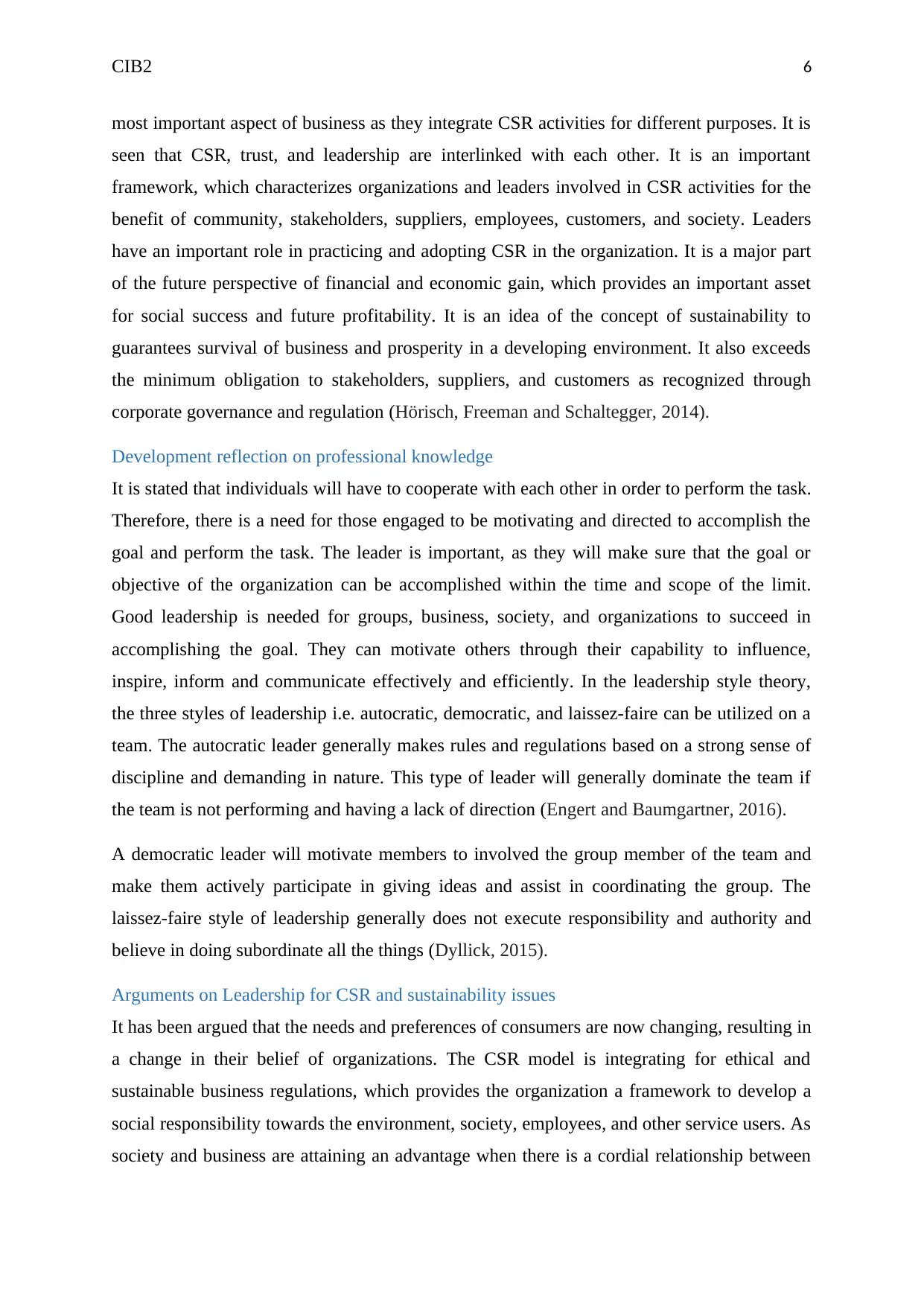
CIB2 6
most important aspect of business as they integrate CSR activities for different purposes. It is
seen that CSR, trust, and leadership are interlinked with each other. It is an important
framework, which characterizes organizations and leaders involved in CSR activities for the
benefit of community, stakeholders, suppliers, employees, customers, and society. Leaders
have an important role in practicing and adopting CSR in the organization. It is a major part
of the future perspective of financial and economic gain, which provides an important asset
for social success and future profitability. It is an idea of the concept of sustainability to
guarantees survival of business and prosperity in a developing environment. It also exceeds
the minimum obligation to stakeholders, suppliers, and customers as recognized through
corporate governance and regulation (Hörisch, Freeman and Schaltegger, 2014).
Development reflection on professional knowledge
It is stated that individuals will have to cooperate with each other in order to perform the task.
Therefore, there is a need for those engaged to be motivating and directed to accomplish the
goal and perform the task. The leader is important, as they will make sure that the goal or
objective of the organization can be accomplished within the time and scope of the limit.
Good leadership is needed for groups, business, society, and organizations to succeed in
accomplishing the goal. They can motivate others through their capability to influence,
inspire, inform and communicate effectively and efficiently. In the leadership style theory,
the three styles of leadership i.e. autocratic, democratic, and laissez-faire can be utilized on a
team. The autocratic leader generally makes rules and regulations based on a strong sense of
discipline and demanding in nature. This type of leader will generally dominate the team if
the team is not performing and having a lack of direction (Engert and Baumgartner, 2016).
A democratic leader will motivate members to involved the group member of the team and
make them actively participate in giving ideas and assist in coordinating the group. The
laissez-faire style of leadership generally does not execute responsibility and authority and
believe in doing subordinate all the things (Dyllick, 2015).
Arguments on Leadership for CSR and sustainability issues
It has been argued that the needs and preferences of consumers are now changing, resulting in
a change in their belief of organizations. The CSR model is integrating for ethical and
sustainable business regulations, which provides the organization a framework to develop a
social responsibility towards the environment, society, employees, and other service users. As
society and business are attaining an advantage when there is a cordial relationship between
most important aspect of business as they integrate CSR activities for different purposes. It is
seen that CSR, trust, and leadership are interlinked with each other. It is an important
framework, which characterizes organizations and leaders involved in CSR activities for the
benefit of community, stakeholders, suppliers, employees, customers, and society. Leaders
have an important role in practicing and adopting CSR in the organization. It is a major part
of the future perspective of financial and economic gain, which provides an important asset
for social success and future profitability. It is an idea of the concept of sustainability to
guarantees survival of business and prosperity in a developing environment. It also exceeds
the minimum obligation to stakeholders, suppliers, and customers as recognized through
corporate governance and regulation (Hörisch, Freeman and Schaltegger, 2014).
Development reflection on professional knowledge
It is stated that individuals will have to cooperate with each other in order to perform the task.
Therefore, there is a need for those engaged to be motivating and directed to accomplish the
goal and perform the task. The leader is important, as they will make sure that the goal or
objective of the organization can be accomplished within the time and scope of the limit.
Good leadership is needed for groups, business, society, and organizations to succeed in
accomplishing the goal. They can motivate others through their capability to influence,
inspire, inform and communicate effectively and efficiently. In the leadership style theory,
the three styles of leadership i.e. autocratic, democratic, and laissez-faire can be utilized on a
team. The autocratic leader generally makes rules and regulations based on a strong sense of
discipline and demanding in nature. This type of leader will generally dominate the team if
the team is not performing and having a lack of direction (Engert and Baumgartner, 2016).
A democratic leader will motivate members to involved the group member of the team and
make them actively participate in giving ideas and assist in coordinating the group. The
laissez-faire style of leadership generally does not execute responsibility and authority and
believe in doing subordinate all the things (Dyllick, 2015).
Arguments on Leadership for CSR and sustainability issues
It has been argued that the needs and preferences of consumers are now changing, resulting in
a change in their belief of organizations. The CSR model is integrating for ethical and
sustainable business regulations, which provides the organization a framework to develop a
social responsibility towards the environment, society, employees, and other service users. As
society and business are attaining an advantage when there is a cordial relationship between
Paraphrase This Document
Need a fresh take? Get an instant paraphrase of this document with our AI Paraphraser
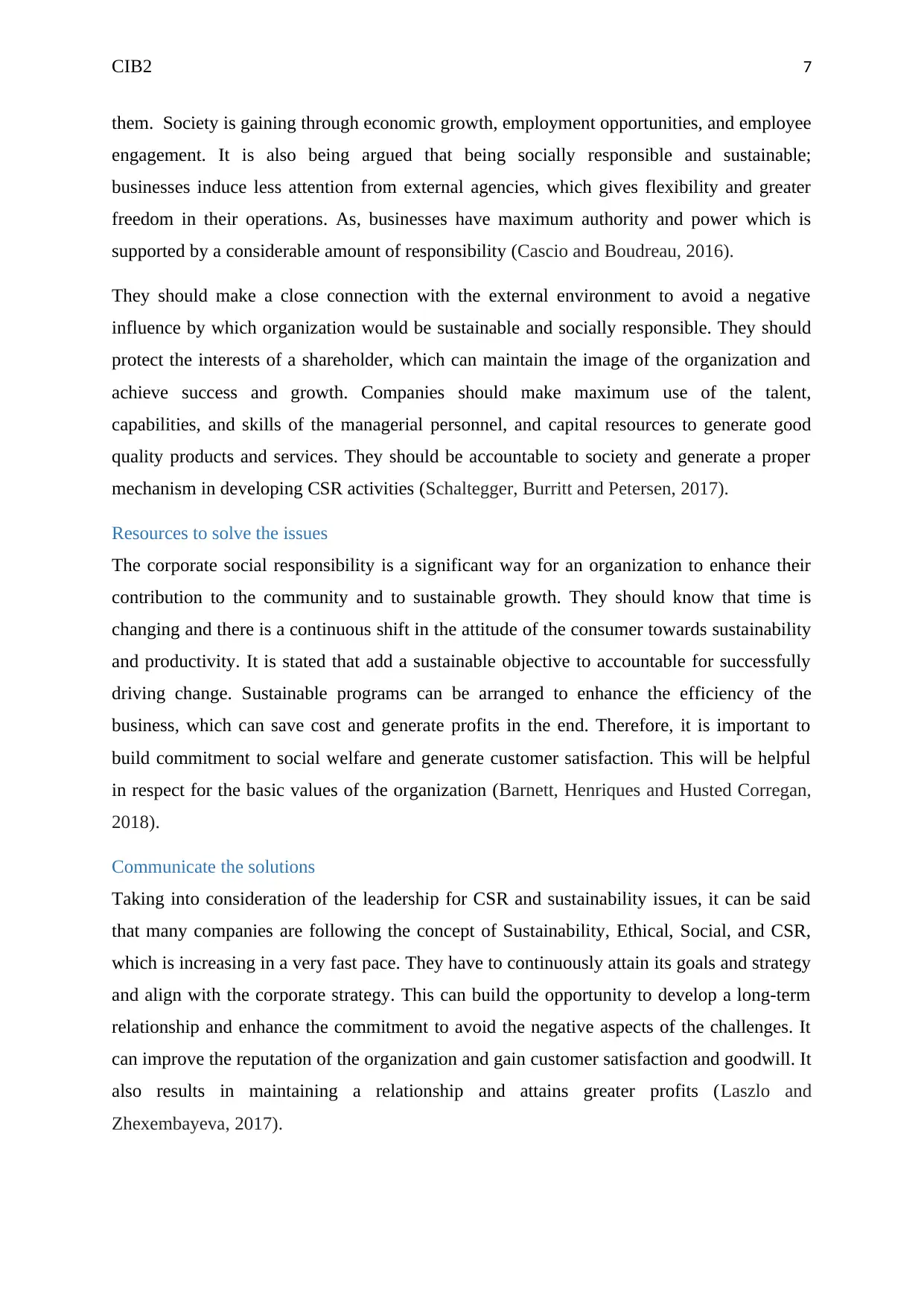
CIB2 7
them. Society is gaining through economic growth, employment opportunities, and employee
engagement. It is also being argued that being socially responsible and sustainable;
businesses induce less attention from external agencies, which gives flexibility and greater
freedom in their operations. As, businesses have maximum authority and power which is
supported by a considerable amount of responsibility (Cascio and Boudreau, 2016).
They should make a close connection with the external environment to avoid a negative
influence by which organization would be sustainable and socially responsible. They should
protect the interests of a shareholder, which can maintain the image of the organization and
achieve success and growth. Companies should make maximum use of the talent,
capabilities, and skills of the managerial personnel, and capital resources to generate good
quality products and services. They should be accountable to society and generate a proper
mechanism in developing CSR activities (Schaltegger, Burritt and Petersen, 2017).
Resources to solve the issues
The corporate social responsibility is a significant way for an organization to enhance their
contribution to the community and to sustainable growth. They should know that time is
changing and there is a continuous shift in the attitude of the consumer towards sustainability
and productivity. It is stated that add a sustainable objective to accountable for successfully
driving change. Sustainable programs can be arranged to enhance the efficiency of the
business, which can save cost and generate profits in the end. Therefore, it is important to
build commitment to social welfare and generate customer satisfaction. This will be helpful
in respect for the basic values of the organization (Barnett, Henriques and Husted Corregan,
2018).
Communicate the solutions
Taking into consideration of the leadership for CSR and sustainability issues, it can be said
that many companies are following the concept of Sustainability, Ethical, Social, and CSR,
which is increasing in a very fast pace. They have to continuously attain its goals and strategy
and align with the corporate strategy. This can build the opportunity to develop a long-term
relationship and enhance the commitment to avoid the negative aspects of the challenges. It
can improve the reputation of the organization and gain customer satisfaction and goodwill. It
also results in maintaining a relationship and attains greater profits (Laszlo and
Zhexembayeva, 2017).
them. Society is gaining through economic growth, employment opportunities, and employee
engagement. It is also being argued that being socially responsible and sustainable;
businesses induce less attention from external agencies, which gives flexibility and greater
freedom in their operations. As, businesses have maximum authority and power which is
supported by a considerable amount of responsibility (Cascio and Boudreau, 2016).
They should make a close connection with the external environment to avoid a negative
influence by which organization would be sustainable and socially responsible. They should
protect the interests of a shareholder, which can maintain the image of the organization and
achieve success and growth. Companies should make maximum use of the talent,
capabilities, and skills of the managerial personnel, and capital resources to generate good
quality products and services. They should be accountable to society and generate a proper
mechanism in developing CSR activities (Schaltegger, Burritt and Petersen, 2017).
Resources to solve the issues
The corporate social responsibility is a significant way for an organization to enhance their
contribution to the community and to sustainable growth. They should know that time is
changing and there is a continuous shift in the attitude of the consumer towards sustainability
and productivity. It is stated that add a sustainable objective to accountable for successfully
driving change. Sustainable programs can be arranged to enhance the efficiency of the
business, which can save cost and generate profits in the end. Therefore, it is important to
build commitment to social welfare and generate customer satisfaction. This will be helpful
in respect for the basic values of the organization (Barnett, Henriques and Husted Corregan,
2018).
Communicate the solutions
Taking into consideration of the leadership for CSR and sustainability issues, it can be said
that many companies are following the concept of Sustainability, Ethical, Social, and CSR,
which is increasing in a very fast pace. They have to continuously attain its goals and strategy
and align with the corporate strategy. This can build the opportunity to develop a long-term
relationship and enhance the commitment to avoid the negative aspects of the challenges. It
can improve the reputation of the organization and gain customer satisfaction and goodwill. It
also results in maintaining a relationship and attains greater profits (Laszlo and
Zhexembayeva, 2017).
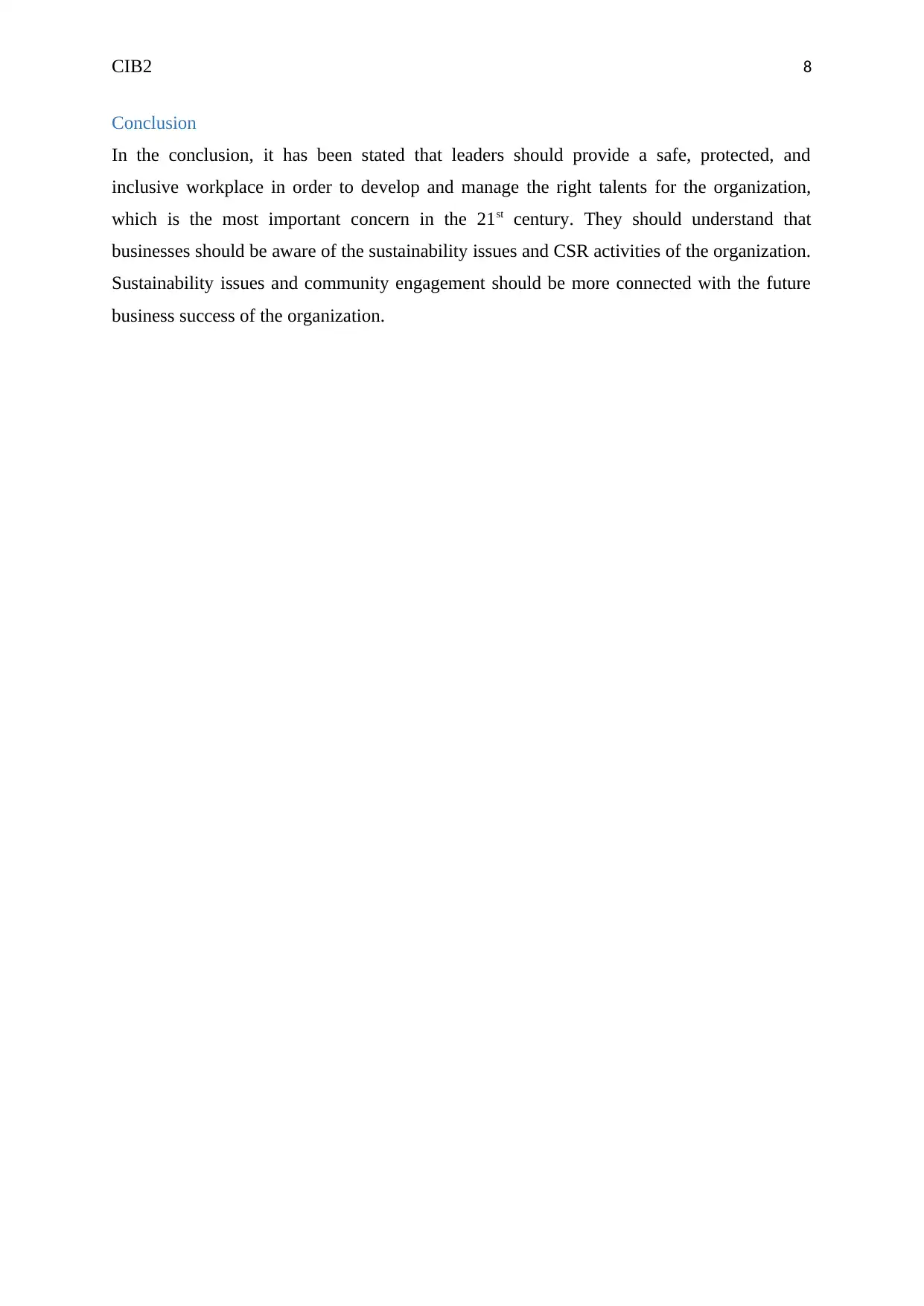
CIB2 8
Conclusion
In the conclusion, it has been stated that leaders should provide a safe, protected, and
inclusive workplace in order to develop and manage the right talents for the organization,
which is the most important concern in the 21st century. They should understand that
businesses should be aware of the sustainability issues and CSR activities of the organization.
Sustainability issues and community engagement should be more connected with the future
business success of the organization.
Conclusion
In the conclusion, it has been stated that leaders should provide a safe, protected, and
inclusive workplace in order to develop and manage the right talents for the organization,
which is the most important concern in the 21st century. They should understand that
businesses should be aware of the sustainability issues and CSR activities of the organization.
Sustainability issues and community engagement should be more connected with the future
business success of the organization.
⊘ This is a preview!⊘
Do you want full access?
Subscribe today to unlock all pages.

Trusted by 1+ million students worldwide
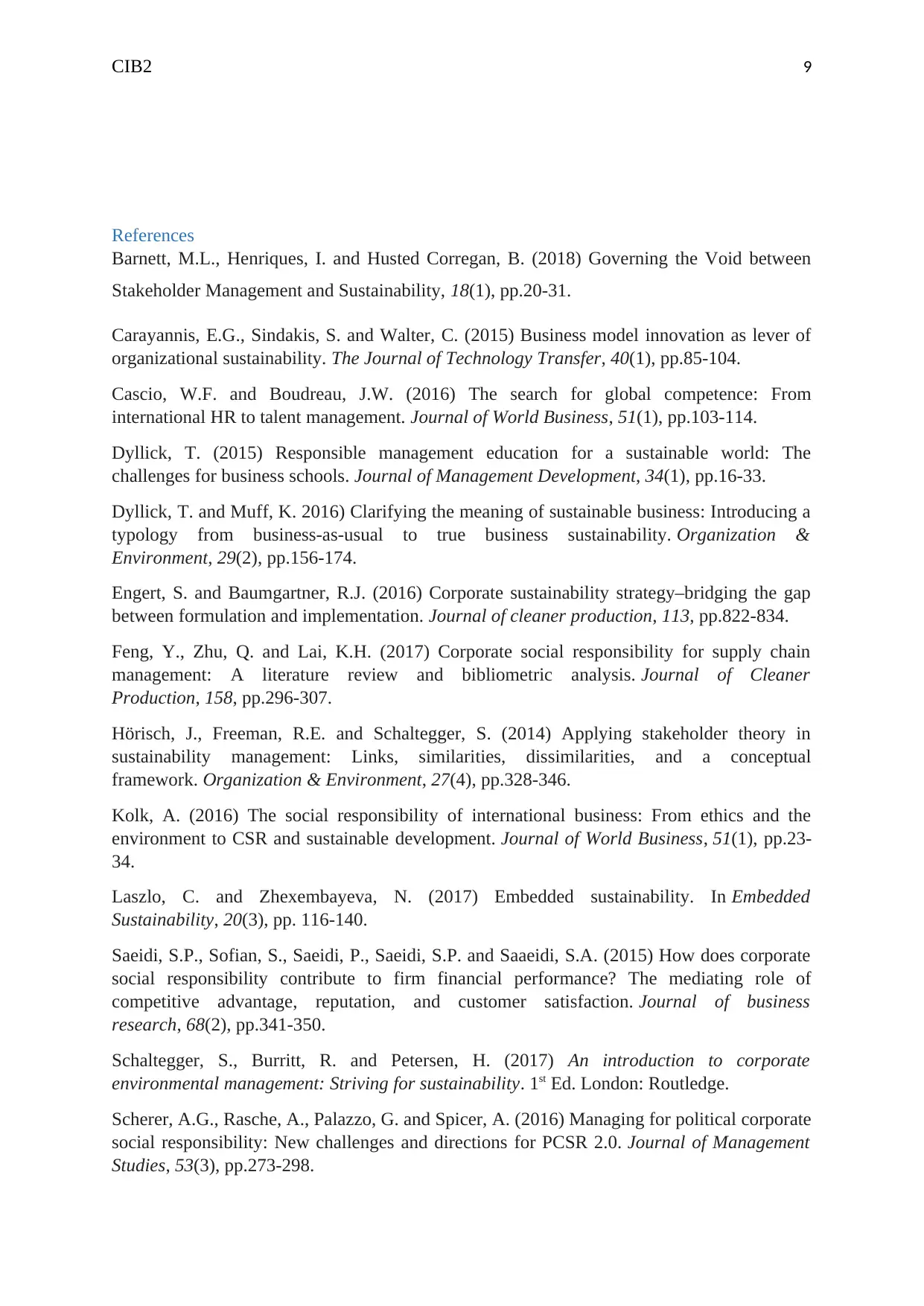
CIB2 9
References
Barnett, M.L., Henriques, I. and Husted Corregan, B. (2018) Governing the Void between
Stakeholder Management and Sustainability, 18(1), pp.20-31.
Carayannis, E.G., Sindakis, S. and Walter, C. (2015) Business model innovation as lever of
organizational sustainability. The Journal of Technology Transfer, 40(1), pp.85-104.
Cascio, W.F. and Boudreau, J.W. (2016) The search for global competence: From
international HR to talent management. Journal of World Business, 51(1), pp.103-114.
Dyllick, T. (2015) Responsible management education for a sustainable world: The
challenges for business schools. Journal of Management Development, 34(1), pp.16-33.
Dyllick, T. and Muff, K. 2016) Clarifying the meaning of sustainable business: Introducing a
typology from business-as-usual to true business sustainability. Organization &
Environment, 29(2), pp.156-174.
Engert, S. and Baumgartner, R.J. (2016) Corporate sustainability strategy–bridging the gap
between formulation and implementation. Journal of cleaner production, 113, pp.822-834.
Feng, Y., Zhu, Q. and Lai, K.H. (2017) Corporate social responsibility for supply chain
management: A literature review and bibliometric analysis. Journal of Cleaner
Production, 158, pp.296-307.
Hörisch, J., Freeman, R.E. and Schaltegger, S. (2014) Applying stakeholder theory in
sustainability management: Links, similarities, dissimilarities, and a conceptual
framework. Organization & Environment, 27(4), pp.328-346.
Kolk, A. (2016) The social responsibility of international business: From ethics and the
environment to CSR and sustainable development. Journal of World Business, 51(1), pp.23-
34.
Laszlo, C. and Zhexembayeva, N. (2017) Embedded sustainability. In Embedded
Sustainability, 20(3), pp. 116-140.
Saeidi, S.P., Sofian, S., Saeidi, P., Saeidi, S.P. and Saaeidi, S.A. (2015) How does corporate
social responsibility contribute to firm financial performance? The mediating role of
competitive advantage, reputation, and customer satisfaction. Journal of business
research, 68(2), pp.341-350.
Schaltegger, S., Burritt, R. and Petersen, H. (2017) An introduction to corporate
environmental management: Striving for sustainability. 1st Ed. London: Routledge.
Scherer, A.G., Rasche, A., Palazzo, G. and Spicer, A. (2016) Managing for political corporate
social responsibility: New challenges and directions for PCSR 2.0. Journal of Management
Studies, 53(3), pp.273-298.
References
Barnett, M.L., Henriques, I. and Husted Corregan, B. (2018) Governing the Void between
Stakeholder Management and Sustainability, 18(1), pp.20-31.
Carayannis, E.G., Sindakis, S. and Walter, C. (2015) Business model innovation as lever of
organizational sustainability. The Journal of Technology Transfer, 40(1), pp.85-104.
Cascio, W.F. and Boudreau, J.W. (2016) The search for global competence: From
international HR to talent management. Journal of World Business, 51(1), pp.103-114.
Dyllick, T. (2015) Responsible management education for a sustainable world: The
challenges for business schools. Journal of Management Development, 34(1), pp.16-33.
Dyllick, T. and Muff, K. 2016) Clarifying the meaning of sustainable business: Introducing a
typology from business-as-usual to true business sustainability. Organization &
Environment, 29(2), pp.156-174.
Engert, S. and Baumgartner, R.J. (2016) Corporate sustainability strategy–bridging the gap
between formulation and implementation. Journal of cleaner production, 113, pp.822-834.
Feng, Y., Zhu, Q. and Lai, K.H. (2017) Corporate social responsibility for supply chain
management: A literature review and bibliometric analysis. Journal of Cleaner
Production, 158, pp.296-307.
Hörisch, J., Freeman, R.E. and Schaltegger, S. (2014) Applying stakeholder theory in
sustainability management: Links, similarities, dissimilarities, and a conceptual
framework. Organization & Environment, 27(4), pp.328-346.
Kolk, A. (2016) The social responsibility of international business: From ethics and the
environment to CSR and sustainable development. Journal of World Business, 51(1), pp.23-
34.
Laszlo, C. and Zhexembayeva, N. (2017) Embedded sustainability. In Embedded
Sustainability, 20(3), pp. 116-140.
Saeidi, S.P., Sofian, S., Saeidi, P., Saeidi, S.P. and Saaeidi, S.A. (2015) How does corporate
social responsibility contribute to firm financial performance? The mediating role of
competitive advantage, reputation, and customer satisfaction. Journal of business
research, 68(2), pp.341-350.
Schaltegger, S., Burritt, R. and Petersen, H. (2017) An introduction to corporate
environmental management: Striving for sustainability. 1st Ed. London: Routledge.
Scherer, A.G., Rasche, A., Palazzo, G. and Spicer, A. (2016) Managing for political corporate
social responsibility: New challenges and directions for PCSR 2.0. Journal of Management
Studies, 53(3), pp.273-298.
Paraphrase This Document
Need a fresh take? Get an instant paraphrase of this document with our AI Paraphraser
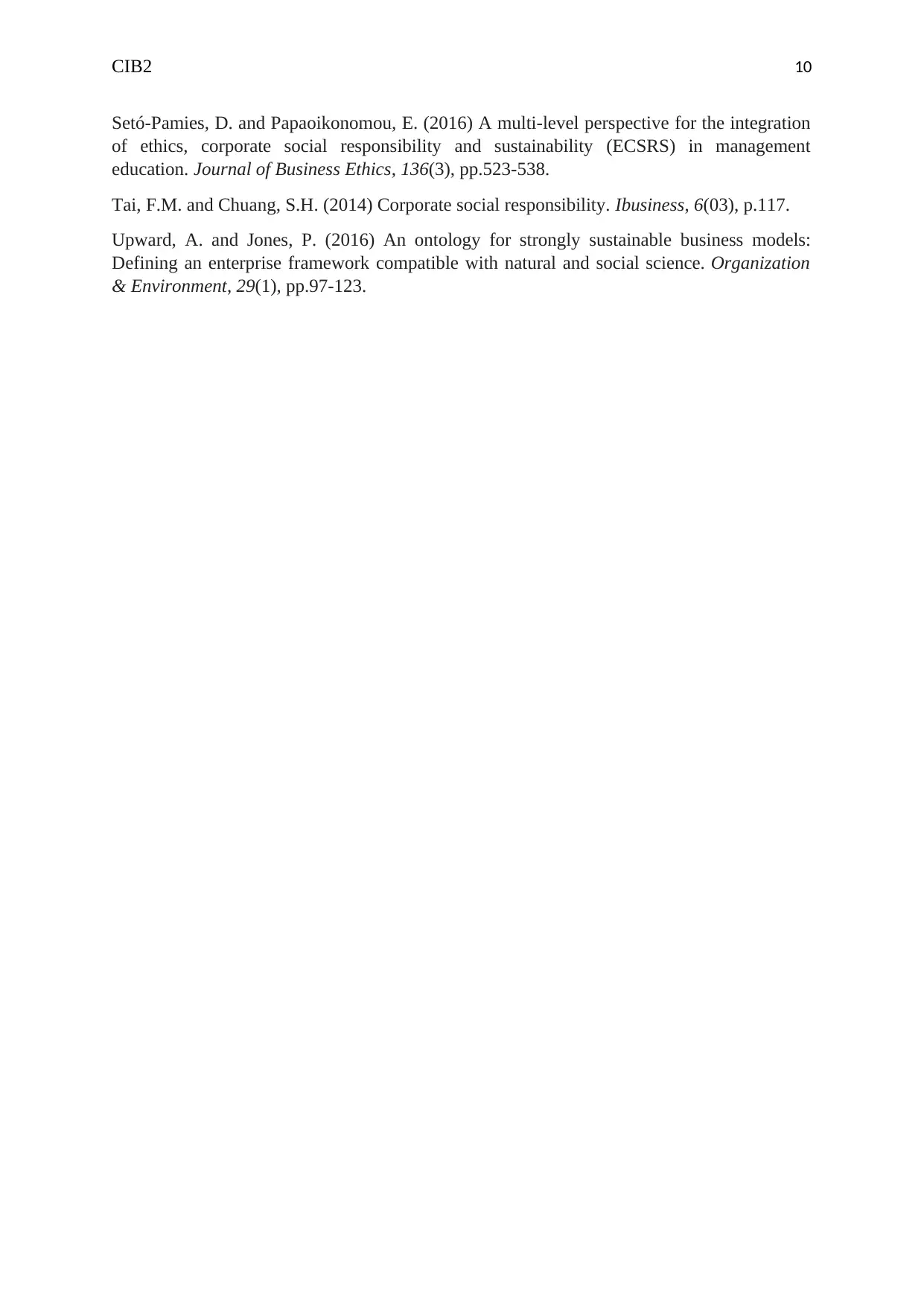
CIB2 10
Setó-Pamies, D. and Papaoikonomou, E. (2016) A multi-level perspective for the integration
of ethics, corporate social responsibility and sustainability (ECSRS) in management
education. Journal of Business Ethics, 136(3), pp.523-538.
Tai, F.M. and Chuang, S.H. (2014) Corporate social responsibility. Ibusiness, 6(03), p.117.
Upward, A. and Jones, P. (2016) An ontology for strongly sustainable business models:
Defining an enterprise framework compatible with natural and social science. Organization
& Environment, 29(1), pp.97-123.
Setó-Pamies, D. and Papaoikonomou, E. (2016) A multi-level perspective for the integration
of ethics, corporate social responsibility and sustainability (ECSRS) in management
education. Journal of Business Ethics, 136(3), pp.523-538.
Tai, F.M. and Chuang, S.H. (2014) Corporate social responsibility. Ibusiness, 6(03), p.117.
Upward, A. and Jones, P. (2016) An ontology for strongly sustainable business models:
Defining an enterprise framework compatible with natural and social science. Organization
& Environment, 29(1), pp.97-123.
1 out of 11
Related Documents
Your All-in-One AI-Powered Toolkit for Academic Success.
+13062052269
info@desklib.com
Available 24*7 on WhatsApp / Email
![[object Object]](/_next/static/media/star-bottom.7253800d.svg)
Unlock your academic potential
Copyright © 2020–2025 A2Z Services. All Rights Reserved. Developed and managed by ZUCOL.





